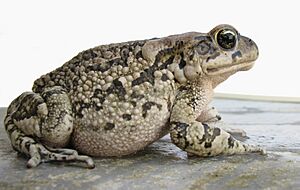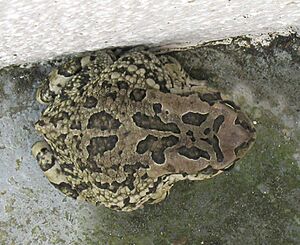Raucous toad facts for kids
Quick facts for kids Raucous toad |
|
|---|---|
 |
|
| Conservation status | |
| Scientific classification | |
| Synonyms | |
|
The raucous toad (Sclerophrys capensis) is a type of toad found in Southern Africa. It's also sometimes called Ranger's toad. These toads are known for their loud calls!
Contents
How the Raucous Toad Got Its Name
The raucous toad's scientific name is Sclerophrys capensis. It belongs to the Bufonidae family, which includes many types of toads.
Scientists first described this toad in 1935. It was named Bufo regularis rangeri by John Hewitt. He found it from collections made by a naturalist named Gordon A. Ranger in South Africa.
Over time, scientists learned more about toads. In 1964, another scientist, Poynton, decided it was a unique species. He changed its name to Bufo rangeri.
Later, in 2006, scientists used DNA to study amphibians. They moved this toad to a new group called Amietophrynus. So, for a while, it was known as Amietophrynus rangeri.
Even more recently, in 2016, scientists found something important. They realized that an older toad specimen, described way back in 1838 by Johann Jakob von Tschudi, was actually the same species. Because of a rule called the Principle of Priority, the oldest name gets to be the official one. That's why its current scientific name is Sclerophrys capensis.
What Does the Raucous Toad Look Like?
The raucous toad is a medium to large-sized toad. It can grow up to about 120 millimeters (about 4.7 inches) long from its snout to its rear end.
Its skin is usually brown or grayish. It has many small, wart-like bumps all over its back and sides. You might see dark brown patches on its back. These patches often appear in pairs along its middle.
On its head, behind and between its eyes, there's often a brown V-shape. The front part of its head usually doesn't have these dark patches.
Like many toads, it has special glands behind each eye. These are called parotoid glands. If the toad feels threatened or gets hurt, these glands can release a whitish liquid. This liquid is a defense mechanism and can be harmful to animals like dogs if they try to bite the toad.
The underside of the toad is whitish. Male toads have a yellow throat area. They also have a dark blue-black bar just behind their throat.
What Does the Raucous Toad Sound Like?
Male raucous toads make a very loud call during the breeding season. It sounds like a repetitive, duck-like quacking sound.
When many males are calling together, they usually spread out. They might sit along the edge of the water or among plants in the water. They often call one after another, taking turns. This is called calling antiphonally.
Habits and Behavior
Raucous toads are more aquatic than many other toad species. This means they spend a good amount of time in or near water. They often live in ponds, dams, and streams. They seem to prefer moving water, so you might find them near fountains or similar places.
These toads are generally shy. However, like many toads, they sometimes visit houses. They are attracted to lights because insects, which they eat, gather there. This usually happens when it's not their breeding season.
If a toad finds a moist, sheltered spot, like behind a flowerpot, it might stay there. If people don't bother it, it can become quite comfortable around humans.
Raucous toads will eat almost any small animal they can catch. Their diet mainly includes insects, like crickets. They can even eat small vertebrates (animals with backbones).
Where Do Raucous Toads Live?
You can find Sclerophrys capensis in several countries in Southern Africa. They live in South Africa, Lesotho, and Eswatini. They are also found in the very southern part of Namibia. Scientists think they might also live in extreme southern Botswana, Mozambique, and Zimbabwe.
What Kind of Places Do They Live In?
Raucous toads live in many different environments. These include fynbos heathland, grasslands, dry thicket forests, and savannas. They can also be found in areas used for farming.
When it's time to breed, they go to water bodies. They use dams, ponds, and pools that form along slow-moving streams. They seem to prefer places where the water stays all year round.



